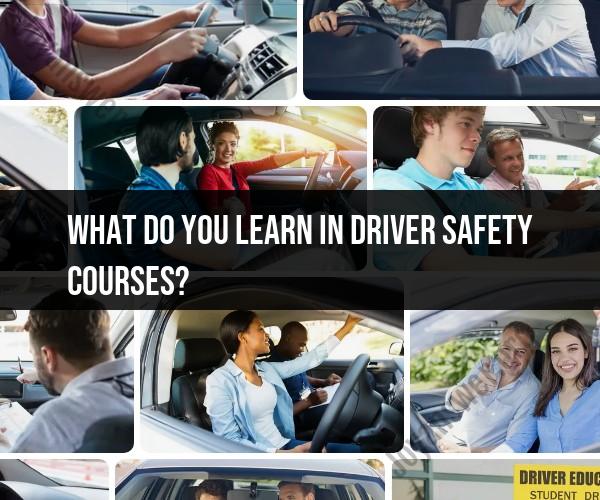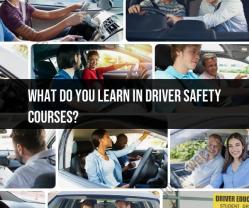What do you learn in driver safety courses?
Driver safety courses cover a range of topics aimed at promoting safe and responsible driving behavior. The specific curriculum can vary depending on the type of driver safety course you are taking. Here are common topics covered in various driver safety courses:
Traffic Laws and Regulations:
- Overview of local and state traffic laws and regulations.
- Explanation of traffic signs, signals, and road markings.
Defensive Driving Techniques:
- Strategies for defensive driving to anticipate and respond to potential hazards.
- Techniques for maintaining a safe following distance and avoiding aggressive driving behaviors.
Safe Driving Practices:
- Emphasis on safe driving habits and responsible behavior on the road.
- Importance of using seat belts and child safety seats.
Distracted Driving Awareness:
- Understanding the dangers of distracted driving, including the use of mobile phones, eating, or other distractions.
- Strategies to minimize distractions while driving.
Impaired Driving Awareness:
- Education on the risks and consequences of driving under the influence of alcohol or drugs.
- Information on blood alcohol concentration (BAC) limits and legal consequences.
Weather and Road Conditions:
- Guidance on how to adjust driving behavior in adverse weather conditions.
- Tips for handling different road surfaces and conditions.
Emergency Situations:
- Techniques for responding to emergency situations, such as skidding, tire blowouts, or brake failure.
- Basic first aid and what to do in the event of an accident.
Understanding Traffic Patterns:
- Insight into traffic flow and patterns to help drivers make informed decisions.
- Tips for navigating intersections and handling intersections safely.
Sharing the Road:
- Information on sharing the road with other vehicles, pedestrians, cyclists, and motorcyclists.
- Awareness of blind spots and strategies for avoiding collisions.
Fatigue and Driver Wellness:
- Recognizing signs of driver fatigue and the dangers associated with drowsy driving.
- Tips for maintaining driver wellness, including adequate rest and breaks.
Insurance Discounts and Point Reduction:
- Explanation of how completing a driver safety course may qualify for insurance discounts or point reduction on driving records.
Specific Course Emphases:
- Depending on the type of driver safety course, there may be specific emphases, such as mature driver skills, motorcycle safety, or commercial driver training.
It's important to note that the content and structure of driver safety courses can vary by jurisdiction and the specific course provider. Some courses are offered online, while others may be conducted in a classroom setting. Before enrolling in a driver safety course, it's advisable to check with the relevant local Department of Motor Vehicles (DMV) or licensing authority to ensure that the course meets the requirements for your location.
What are the core subjects covered in driver safety courses?
Core Topics Covered in Driver Safety Courses
The core topics covered in driver safety courses can vary depending on the specific course, its target audience, and local regulations. However, some common topics include:
- Traffic laws and regulations: This foundational section covers traffic laws, signs, signals, and markings specific to the region where the course is offered. Learners gain an understanding of right-of-way, lane changes, speed limits, and other essential driving regulations.
- Safe driving techniques: The course delves into essential driving skills like proper steering, braking, accelerating, and maintaining lane position. It also emphasizes defensive driving techniques like hazard awareness, scanning the road ahead, and maintaining a safe following distance.
- Understanding hazards and risks: Learners are equipped to identify and anticipate potential hazards on the road, such as weather conditions, road obstacles, other vehicles, and pedestrian behavior. The course also educates them about the dangers of impaired driving, distracted driving, and drowsy driving.
- Vehicle operation and maintenance: This section covers basic car maintenance knowledge, such as checking tire pressure, fluid levels, and lights. Learners also gain insights into vehicle controls, emergency procedures, and how to handle common car troubles.
- Decision-making and risk assessment: Driver safety courses emphasize the importance of making responsible decisions behind the wheel. Learners develop critical thinking skills to assess risky situations, avoid potential collisions, and navigate challenging driving scenarios.
Additional topics, depending on the course, may include:
- First aid and CPR: Equipping drivers with basic life-saving skills in case of emergencies.
- Motorcycle safety: Specific rules and techniques for safe motorcycle riding.
- Teen driver education: Tailored guidance for young drivers to address their specific challenges and risks.
By covering these core subjects, driver safety courses aim to equip individuals with the knowledge, skills, and awareness necessary to navigate the roads safely and responsibly. The ultimate goal is to reduce traffic accidents, injuries, and fatalities, fostering a safer driving environment for everyone.
**Remember, the specific content and depth of coverage for these topics may vary depending on the course you choose. It's always recommended to research and select a course that aligns with your needs and meets your local driving requirements.







